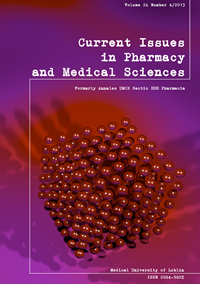Effect of recasting of CoCrMoW dental alloy on its microstructure and corrosion resistance
DOI:
https://doi.org/10.12923/j.2084-980X/26.4/a.17Słowa kluczowe:
recasting, cobalt alloy, durability of prosthetic devices, corrosion resistanceAbstrakt
The procedure consisting in the recasting of previously cast alloy is frequently used in dental laboratories in order to reduce the cost of permanent partial dentures being produced. Such a procedure may result in changed chemical composition of newly produced alloy and may influence its microstructure and corrosion resistance. In this research, the dental alloy CoCrMoW with the trade name Remanium 2001 (Denaturum, Germany) was used. Three groups of dental alloys were prepared by mixing 50% brand new alloy with alloy remnants from previous castings. The first group used 100% brand new alloy and served as control one (R1). The second group (R2) consisted of equal amounts of brand new alloy and alloy remnants cast only once. The third group (R3) contained 50% brand new alloy and alloy cast twice. Microstructural analysis was performed as well as chemical composition and corrosion was investigated in artificial saliva environment. The following corrosion resistance has been demonstrated on the basis of electrochemical research for three cobalt alloys: R1>R3>R2. Furthermore, it has been demonstrated that new material should be used in casting, and if previously cast material is used, it should be mixed with new material in the ratio 50:50. The recasting procedure can be safely used in dentistry.
Bibliografia
1. Al-Ali A.A.: Evaluation of Macrohardness of Recasted Cobalt-Chromium Alloy. Al-Rafidain Dent. J., 7, 111, 2007.
2. Al-Hiyasat A.S., Darmani H.: The effects of recasting on the cytotoxicity of base metal alloys, J. Prosthet. Dent., 93, 158, 2005.
3. Ameer M.A., Khamis E., Al-Motlaq M.: Electrochemical behaviour of recasting Ni-Cr and Co–Cr non-precious dental alloys, Corr. Sci., 46, 2825, 2004.
4. Harcourt H.J.: The remelting of cobalt-chromium alloys. Br Dent J., 6, 198, 1962.
5. Hodgson A.W.E. et al.: Passive and transpassive behavior of CoCrMo in simulated biological solutions, Electrochim. Acta, 49, 2167, 2004.
6. Khamis E, Seddik M.: Corrosion evaluate-on of recasting non-precious dental alloys. Int. Dent. J., 45, 209, 1995.
7. Klimek L. et al.: The effect of recasting on corrosion of DUCINOX prosthetic alloy, Arch. Foundry Engin., 9, 67, 2009.
8. Muñoz A.I., Julián L.C., Influence of electrochemical potential on the tribocorrosion behaviour of high carbon CoCrMo biomedical alloy in simulated body fluids by electrochemical impedance spectroscopy, Electrochim. Acta, 55, 5428, 2010.
9. Peraire M. et al.: Effects of recasting on the chemical composition, microstructure, microhardness, and ion release of 3 dental casting alloys and titanium, Int. J. Prosthodont., 20, 286, 2007.
10. Ramírez Vidaurri L.E. et al.: Cooling rate and carbon content effect on the fraction of secondary phases precipitate in as-cast microstructure of ASTM F75 alloy. J. Mater. Proc. Technol., 209, 1681, 2009.
11. Ramírez Vidaurri L.E. et al.: Precipitation path of secondary phases during solidification of the CoCrMoC alloy. Scr. Mater., 47, 811, 2002.
12. Sheffick L.N., editors (1993). The effect of remelting and casting procedures on castability and che-mical composition of dental alloys. MSc thesis. College of Dentistry. University of Baghdad.
13. Walczak et al.: The issue of using remelted CoCrMo alloys in dental prosthetics. Arch. Civ. Mech. Eng. 12, 171, 2012.
14. Walczak M., Pieniak D., Niewczas A.M.: Effect of recasting on the useful properties CoCrMoW alloy. Eksploatacja i Niezawodnosc –Maintenance and Reliability. 2013 (In preparation).
Pobrania
Opublikowane
Numer
Dział
Licencja
Prawa autorskie (c) 2013 Authors

Praca jest udostępniana na licencji Creative Commons Attribution-NonCommercial-NoDerivatives 3.0 Unported License.


